Winter 2007 (PDF)
Contents
Celiac Disease Awareness Campaign Update
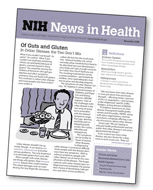
“Of Guts and Gluten: In Celiac Disease, the Two Don’t Mix,” was the front-page feature in the November 2006 issue of the NIH News in Health newsletter.
National media attention and public outreach efforts continue to increase the visibility of the National Institutes of Health (NIH) Celiac Disease Awareness Campaign.
In addition to being mentioned in a November 1, 2006, article on celiac disease in USA Today, a national newspaper that reaches 5 million readers, the Awareness Campaign received press from WABC New York Radio, which has 250,000 listeners in the New York metropolitan area; PR Newswire, which reaches more than 4,700 newsrooms, 3,600 websites and online databases, and 80,000 journalists nationwide; and NIH News in Health, a monthly newsletter mailed to 6,500 senior centers, medical libraries, and community health clinics around the country. The online version of the newsletter receives about 20,000 hits per month.
“Celiac disease seems to be a widespread problem and it is really underdiagnosed,” said Harrison Wein, editor of NIH News in Health. “We really wanted to get the word out about it because most people don’t know about celiac disease.”
“Of Guts and Gluten: In Celiac Disease, the Two Don’t Mix,” was the front-page feature in the November 2006 issue of the newsletter, which you can read at http://newsinhealth.nih.gov/2006/November/docs/01features_01.htm.
Conference Update
To promote the Awareness Campaign among health professionals and people with celiac disease, the National Institute of Diabetes and Digestive and Kidney Diseases (NIDDK) staffed booths at the American College of Gastroenterology Annual Scientific Meeting in Las Vegas from October 20 to 25 and the International Celiac Disease Symposium in New York City from November 9 to 11.
Stephen James, M.D., director of the NIDDK Division of Digestive Diseases and Nutrition, gave presentations at the International Celiac Disease Symposium to scientists, health care professionals, and people with celiac disease about the formation, activities, and progress of the Awareness Campaign. The presentation slides will be available on the Awareness Campaign website soon.
An estimated 700 Symposium attendees—physicians, gastroenterologists, dietitians, people with celiac disease, and staff from voluntary organizations—visited the Awareness Campaign booth, where 625 copies of publications including the NIDDK celiac disease fact sheet and the NIH Consensus Statement on Celiac Disease were distributed. Visitors to the booth shared their interest in educating physicians and other health care providers within their communities about celiac disease.
The next International Celiac Disease Symposium, which is organized by the Celiac Disease Center at Columbia University, is slated for 2008 in Amsterdam.
Website and Email Newsletter Update
During the holiday season, the Awareness Campaign website featured an article on staying gluten-free while enjoying seasonal celebrations. Celiac Disease News subscribers received a special email notice from the Awareness Campaign notifying them that the article was available.
The number of subscribers to Celiac Disease News has grown to nearly 1,100 from 84, when the Awareness Campaign began last July. About 10 new subscribers are added daily to the newsletter database through the NIDDK website signup page at http://catalog.niddk.nih.gov/newsletter.cfm.
Nearly 22,000 visitors logged on to the Awareness Campaign website between October 1, 2006, and January 1, 2007. Thank you to everyone who responded to the question posted on the site about barriers to diagnosing celiac disease. Comments and suggestions will help shape future Awareness Campaign activity planning.
Most of the comments were from physicians, dietitians, nurses, health educators, other health professionals, and people diagnosed with celiac disease. The barriers most frequently cited were
lack of knowledge about celiac disease among health care providers
lack of awareness about the disease among health care providers—unwillingness to test based on nontraditional symptoms
lack of familiarity with
the severity and complications of the disease
screening and diagnostic procedures—blood test versus traditional endoscopy and biopsy
increasing prevalence of celiac disease in the U.S. population
confusion of celiac disease with other gastrointestinal diseases such as irritable bowel syndrome
The next discussion question will focus on how health care professionals prefer to receive new and updated medical information. Log on to the “Practice Guidelines and Tools” page at
www.celiac.nih.gov/PracticeTools.aspx to send your comments.
[Top]
Featured in the NIDDK Reference Collection
What You Should Know About Celiac Disease
This article, which appeared in Diabetes Self Management, helps readers with diabetes understand what celiac disease is and the interplay of diabetes and celiac disease in people who have both conditions.
In people with type 1 diabetes, the malabsorption of nutrients from undiagnosed celiac disease can lead to frequent, unexplained low or high blood glucose readings. Treating celiac disease should make keeping diabetes under control easier.
The article explains celiac disease and its diagnosis, complications, and treatment, as well as how to manage both diseases. It includes a table of the carbohydrate content of selected gluten-free foods, a list of manufacturers and retailers of gluten-free products, a list of books and other resources about celiac disease, and a description of four national support groups through which readers can find additional information.
The article is available from R.A. Rapaport Publishing Inc., 150 West 22nd Street, New York, NY 10011, 800–234–0923. Visit www.catalog.niddk.nih.gov/resources for more resources on celiac disease and diabetes.
The Ultimate Guide to Gluten-Free Living
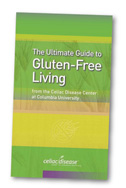
Maintaining a gluten-free diet can be a daily challenge for people with celiac disease. In addition to avoiding gluten-containing foods made with wheat, barley, and rye, people with celiac disease also need to be concerned about less-obvious sources of gluten, such as some herbal supplements, lipsticks, and lip balms.
To help with these challenges, the Celiac Disease Center at Columbia University has published an on-the-go pocket guide, The Ultimate Guide to Gluten-Free Living, that lists gluten-free products by name.
The guide also includes sections on creating a gluten-free kitchen and grocery list and eating gluten-free in restaurants, at social events, during travel, and when partaking of food used in worship services.
Please visit www.catalog.niddk.nih.gov/resources for more information about how to order the guide.
[Top]
Additional Resources
Osteoporosis and Celiac Disease
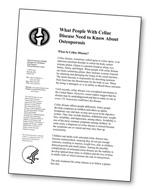
People with untreated celiac disease are at increased risk for osteoporosis because their bodies don’t absorb the calcium they need to maintain strong and healthy bones. Osteoporosis is a disease that causes bones to weaken and fracture. A lack of calcium and physical activity, a history of smoking and drinking, and having family members with the disease can increase the risk of developing osteoporosis.
When people with celiac disease adopt a gluten-free diet, their bodies usually begin absorbing calcium and other nutrients normally within a few months. However, they still need to maintain a healthy diet, exercise regularly, and possibly take medicine for osteoporosis prevention
and treatment.
Visit www.niams.nih.gov/Health_Info/Bone/Osteoporosis/Conditions_Behaviors/celiac.asp to read a copy of a fact sheet entitled What People With Celiac Disease Need to Know About Osteoporosis from the National Institute of Arthritis and Musculoskeletal and Skin Diseases.
Online Celiac Disease Training Course
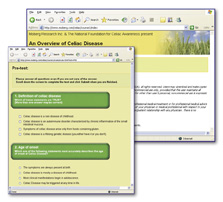
To take the course, visit www.moberg.com/celiac/course1/index.html.The National Foundation for Celiac Awareness (NFCA) and Moberg Research, with funding from the National Institutes of Health (NIH), are testing the usefulness of an interactive, online celiac disease training course. The NFCA and Moberg Research designed the course, “An Overview of Celiac Disease,” to use online training to provide doctors and people with celiac disease more information about the condition. The goal was to increase knowledge about celiac disease among those who took the course by at least 30 percent.
Locate a Pediatric Gastroenterologist
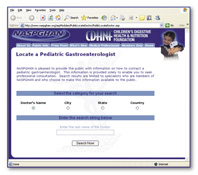
Anyone searching for a pediatric gastroenterologist can find help on the North American Society for Pediatric Gastroenterology, Hepatology and Nutrition (NASPGHAN) website.
The site, www.naspghan.org/aspModules/PublicLocateDoctor/PublicLocateDoctor.asp, allows you to search by city, state, or doctor’s name and is limited to specialists who are NASPGHAN members. NASPGHAN is a professional membership organization of more than 800 pediatric gastroenterologists, predominantly in 46 states, the District of Columbia, Puerto Rico, and eight Canadian provinces.
[Top]
Other Celiac Disease News
FDA Proposes Food-labeling Rules
The U.S. Food and Drug Administration (FDA) has proposed a definition of “gluten-free” to use in voluntary food labeling. The proposed rule was published in the January 23, 2007, Federal Register. The FDA is accepting written or electronic comments on the proposed definition through April 23, 2007. Visit www.fda.gov/OHRMS/DOCKETS/98fr/05n-0279-npr0001.pdf for more information.
[Top]
Upcoming Events
ACP Internal Medicine 2007 Conference
Celiac Disease Awareness Campaign staff will exhibit Awareness Campaign materials at the American College of Physicians (ACP) “Internal Medicine 2007” conference at the San Diego Convention Center from April 19 to 21. Please visit the Awareness Campaign booth if you attend the conference. For more information and to register, visit the ACP website at www.acponline.org/cme/as/2007.
Celiac Disease News
Celiac Disease News, an email newsletter, is sent to subscribers four times a year by the National Digestive Diseases Information Clearinghouse (NDDIC). The newsletter features news about celiac disease, special events, patient and professional meetings, and new publications available from the NDDIC and other organizations. If you would like to subscribe, send an email to niddk@info.niddk.nih.gov. Please visit www.celiac.nih.gov/News.aspx to read or download a PDF version of the newsletter.
To meet the need for comprehensive and current information about celiac disease, the National Digestive Diseases Information Clearinghouse, a service of the National Institute of Diabetes and Digestive and Kidney Diseases (NIDDK), launched the Celiac Disease Awareness Campaign. The Awareness Campaign is the result of the combined ideas and efforts of the professional and voluntary organizations that focus on celiac disease, along with the NIDDK, the National Institutes of Health, and the Centers for Disease Control and Prevention.
Visit www.celiac.nih.gov to learn more about the Awareness Campaign.
Executive Editor: Stephen P. James, M.D.
Stephen P. James, M.D., is the director of the Division of Digestive Diseases and Nutrition within the National Institute of Diabetes and Digestive and Kidney Diseases (NIDDK). As director, Dr. James oversees planning, implementation, and evaluation of a national research effort focused on gastrointestinal, pancreatic, hepatobiliary, and nutrition diseases and conditions. Before joining the NIDDK in 2001, Dr. James directed the division of gastroenterology at the University of Maryland’s School of Medicine for 10 years.

National Digestive Diseases Information Clearinghouse
2 Information Way
Bethesda, MD 20892-3750
Phone: 1-800-891-5389
Fax: 703-738-4929
Email: nddic@info.niddk.nih.gov
Privacy | Disclaimer | Accessibility